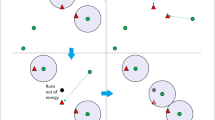Abstract
We consider the load balancing and coverage problem of femtocell networks in indoor environment. We propose a novel framework exploiting the Voronoi diagram with respect to the radio propagation distance. Our initial power assignment scheme achieves maximal indoor coverage with minimized maximum required transmit power, which results in reduced interference. Our approach can adopt any radio propagation model to achieve more accurate coverage for an indoor environment with various obstacles. Time varying data traffic may cause unbalanced data load of base stations producing traffic overload. Our dynamic power control algorithm redistributes the data load by automatically adjusting transmit power levels according to data traffic estimation while preserving coverage. Moreover, we present an algorithm to cope with the dynamic deletion and insertion of femto base stations. Simulations show that the proposed scheme achieves better coverage, reduced interference, and good load balance compared to previous algorithms.













Similar content being viewed by others
References
Chandrasekhar, V., Andrews, J., & Gatherer, A. (2008). Femtocell networks: A survey. IEEE Communications Magazine, 46(9), 59–67.
Borrelli, A., Monti, C., Vari, M., & Mazzenga, F. (2004). Channel models for IEEE 802.11b indoor system design. In 2004 IEEE International Conference on Communications, vol. 6, pp. 3701–3705.
Bonek, E. (1999). Tunnels, corridors, and other special environments. COST Action 231: Digital mobile radio towards future generation systems, pp. 190–207.
Rizk, K., Wagen, J.-F., & Gardiol, F. (1997). Two-dimensional ray-tracing modeling for propagation prediction in microcellular environments. IEEE Transactions on Vehicular Technology, 46(2), 508–518.
Togo, T., Yoshii, I., & Kohno, R. (1998). Dynamic cell-size control according to geographical mobile distribution in a ds/cdma cellular system. In The 9th IEEE international symposium on personal, indoor and mobile radio communications, vol. 2, pp. 677–681.
Jalali, A. (1998). On cell breathing in cdma networks. In IEEE International conference on communications, vol. 2, pp. 985–988.
Bejerano, Y., & jae Han, S. (2009). Cell breathing techniques for load balancing in wireless lans. IEEE Transactions on Mobile Computing, 8(6), 735–749.
Ye, Q., Rong, B., Chen, Y., Al-Shalash, M., Caramanis, C., & Andrews, J. (2013). User association for load balancing in heterogeneous cellular networks. IEEE Transactions on Wireless Communications, 12(6), 2706–2716.
Jo, H.-S., Mun, C., Moon, J., & Yook, J.-G. (2009). Interference mitigation using uplink power control for two-tier femtocell networks. IEEE Transactions on Wireless Communications, 8(10), 4906–4910.
Arulselvan, N., Ramachandran, V., Kalyanasundaram, S., & Han,G. (2009). Distributed power control mechanisms for HSDPA femtocells. IEEE 69th vehicular technology conference, pp. 1–5.
Zahir, T., Arshad, K., Ko,Y., & Moessner, K. (2011). A downlink power control scheme for interference avoidance in femtocells. In 7th international wireless communications and mobile computing conference, pp. 1222–1226.
Chandrasekhar, V., Andrews, J., Muharemovict, T., Shen, Z., & Gatherer, A. (2009). Power control in two-tier femtocell networks. IEEE Transactions on Wireless Communications, 8(8), 4316–4328.
Claussen, H., Ho, L. T. W., & Samuel, L. G. (2008). An overview of the femtocell concept. Bell Labs Technical Journal, 13(1), 221–245.
Yun, S., & Cho, D.-H. (Sep. 2010). Traffic density based power control scheme for femto ap. IEEE 21st international symposium on personal indoor and mobile radio communications, pp. 1378–1383.
Mach, P., & Becvar, Z. (2010). Dynamic power control mechanism for femtocells based on the frame utilization. In 6th international conference on wireless and mobile communications, pp. 498–503.
Mahmud, S., Khan, G., Zafar, H., Ahmad, K., & Behttani, N. (2013). A survey on femtocells: Benefits deployment models and proposed solutions. Journal of Applied Research and Technology, 11(5), 733–754.
Stergiopoulos, J., & Tzes, A. (2009). Voronoi-based coverage optimization for mobile networks with limited sensing range-a directional search approach. In American control conference, 2009. ACC’09. IEEE, pp. 2642–2647.
He, S., Chen, J., Jiang, F., Yau, D. K., Xing, G., & Sun, Y. (2013). Energy provisioning in wireless rechargeable sensor networks. IEEE Transactions on Mobile Computing, 12(10), 1931–1942.
He, J., Verstak, A., Watson, L., Stinson, C., Ramakrishnan, N., Shaffer, C., et al. (2004). Globally optimal transmitter placement for indoor wireless communication systems. IEEE Transactions on Wireless Communications, 3(6), 1906–1911.
Fortune, S., Gay, D., Kernighan, B., Landron, O., Valenzuela, R., & Wright, M. (1995). Wise design of indoor wireless systems: Practical computation and optimization. IEEE Computational Science Engineering, 2(1), 58–68.
de Berg, M., Overmars, M., Cheong, O., & van Kreveld, M. (2010). Computational geometry: Algorithms and applications. Berlin: Springer.
So, A. M.-C., & Ye, Y. (2005). On solving coverage problems in a wireless sensor network using voronoi diagrams. In X. Deng & Y. Ye (Eds.), Internet and Network Economics (pp. 584–593). Berlin: Springer.
Bash, B. A., & Desnoyers, P. J. (2007). Exact distributed voronoi cell computation in sensor networks. In Proceedings of the 6th international conference on Information processing in sensor networks, ACM, pp. 236–243.
Alsalih, W., Islam, K., Rodríguez, Y.N., & Xiao, H. (2008). Distributed voronoi diagram computation in wireless sensor networks. In SPAA, p. 364.
Hay Systems Ltd, HSL 2.75G femtocell datasheet. Website, 2010, www.haysystems.com/documents/HSL-2.75G-Femtocell-Datasheet.pdf.
Acknowledgments
This research was supported by Basic Science Research Program through the National Research Foundation of Korea (NRF) funded by the Ministry of Education (No. 2010-0024092).
Author information
Authors and Affiliations
Corresponding author
Additional information
A preliminary version of this paper (under the title Dynamic Power Control for Balanced Data Traffic with Coverage in Femtocell Networks) has appeared in Proceedings of the 8th IEEE IWCMC Conference, Limassol, Cyprus, August 2012.
Rights and permissions
About this article
Cite this article
Shin, D., Choi, S. Power control for data load balancing with coverage in dynamic femtocell networks. Wireless Netw 22, 1145–1159 (2016). https://doi.org/10.1007/s11276-015-1022-0
Published:
Issue Date:
DOI: https://doi.org/10.1007/s11276-015-1022-0




